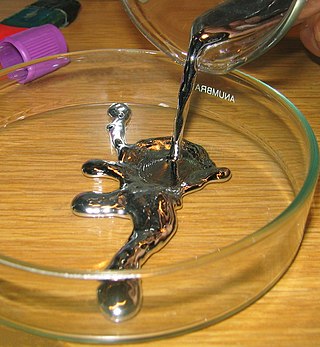
Amygdalin is a naturally occurring chemical compound found in many plants, most notably in the seeds (kernels) of apricots, bitter almonds, apples, peaches, cherries and plums, and in the roots of manioc.

In chemistry, a cyanide is a chemical compound that contains a C≡N functional group. This group, known as the cyano group, consists of a carbon atom triple-bonded to a nitrogen atom.
Hydrogen cyanide is a chemical compound with the formula HCN and structural formula H−C≡N. It is a colorless, extremely poisonous, and flammable liquid that boils slightly above room temperature, at 25.6 °C (78.1 °F). HCN is produced on an industrial scale and is a highly valued precursor to many chemical compounds ranging from polymers to pharmaceuticals. Large-scale applications are for the production of potassium cyanide and adiponitrile, used in mining and plastics, respectively. It is more toxic than solid cyanide compounds due to its volatile nature.

Methylthioninium chloride, commonly called methylene blue, is a salt used as a dye and as a medication. As a medication, it is mainly used to treat methemoglobinemia by chemically reducing the ferric iron in hemoglobin to ferrous iron. Specifically, it is used to treat methemoglobin levels that are greater than 30% or in which there are symptoms despite oxygen therapy. It has previously been used for treating cyanide poisoning and urinary tract infections, but this use is no longer recommended.

Mercury poisoning is a type of metal poisoning due to exposure to mercury. Symptoms depend upon the type, dose, method, and duration of exposure. They may include muscle weakness, poor coordination, numbness in the hands and feet, skin rashes, anxiety, memory problems, trouble speaking, trouble hearing, or trouble seeing. High-level exposure to methylmercury is known as Minamata disease. Methylmercury exposure in children may result in acrodynia in which the skin becomes pink and peels. Long-term complications may include kidney problems and decreased intelligence. The effects of long-term low-dose exposure to methylmercury are unclear.
Cyanogen is the chemical compound with the formula (CN)2. The simplest stable carbon nitride, it is a colorless and highly toxic gas with a pungent odor. The molecule is a pseudohalogen. Cyanogen molecules consist of two CN groups – analogous to diatomic halogen molecules, such as Cl2, but far less oxidizing. The two cyano groups are bonded together at their carbon atoms: N≡C‒C≡N, although other isomers have been detected. The name is also used for the CN radical, and hence is used for compounds such as cyanogen bromide (NCBr) (but see also Cyano radical.)

Methylmercury (sometimes methyl mercury) is an organometallic cation with the formula [CH3Hg]+. It is the simplest organomercury compound. Methylmercury is extremely toxic, and its derivatives are the major source of organic mercury for humans. It is a bioaccumulative environmental toxicant.

Sodium thiosulfate is an inorganic compound with the formula Na2S2O3. Typically it is available as the white or colorless pentahydrate, Na2S2O3·5H2O. The solid is a crystalline substance that dissolves well in water.

An apricot kernel is the apricot seed located within the fruit endocarp, which forms a hard shell around the seed called the pyrena.

Thiosulfate is an oxyanion of sulfur with the chemical formula S2O2−3. Thiosulfate also refers to the compounds containing this anion, which are the salts of thiosulfuric acid, e.g. sodium thiosulfate Na2S2O3. The prefix thio- indicates that the thiosulfate is a sulfate with one oxygen replaced by sulfur. Thiosulfate is tetrahedral at the central S atom. Thiosulfate salts occur naturally. Thiosulfate ion has C3v symmetry, and is produced by certain biochemical processes. It rapidly dechlorinates water and is notable for its use to halt bleaching in the paper-making industry. Thiosulfate salts are mainly used in dying in textiles and the bleaching of natural substances.

Mercury(II) acetate, also known as mercuric acetate is the chemical compound with the formula Hg(O2CCH3)2. Commonly abbreviated Hg(OAc)2, this compound is employed as a reagent to generate organomercury compounds from unsaturated organic precursors. It is a white, water-soluble solid, but some samples can appear yellowish with time owing to decomposition.
4-Dimethylaminophenol (DMAP) is an aromatic compound containing both phenol and amine functional groups. It has the molecular formula C8H11NO.

Hydroxocobalamin, also known as vitamin B12a and hydroxycobalamin, is a vitamin found in food and used as a dietary supplement. As a supplement it is used to treat vitamin B12 deficiency including pernicious anemia. Other uses include treatment for cyanide poisoning, Leber's optic atrophy, and toxic amblyopia. It is given by injection into a muscle or vein.

Metal toxicity or metal poisoning is the toxic effect of certain metals in certain forms and doses on life. Some metals are toxic when they form poisonous soluble compounds. Certain metals have no biological role, i.e. are not essential minerals, or are toxic when in a certain form. In the case of lead, any measurable amount may have negative health effects. It is often thought that only heavy metals can be toxic, but lighter metals such as beryllium and lithium may also be in certain circumstances. Not all heavy metals are particularly toxic, and some are essential, such as iron. The definition may also include trace elements when abnormally high doses may be toxic. An option for treatment of metal poisoning may be chelation therapy, a technique involving the administration of chelation agents to remove metals from the body.

Cyanide poisoning is poisoning that results from exposure to any of a number of forms of cyanide. Early symptoms include headache, dizziness, fast heart rate, shortness of breath, and vomiting. This phase may then be followed by seizures, slow heart rate, low blood pressure, loss of consciousness, and cardiac arrest. Onset of symptoms usually occurs within a few minutes. Some survivors have long-term neurological problems.

Mercury is a chemical element; it has symbol Hg and atomic number 80. It is also known as quicksilver and was formerly named hydrargyrum from the Greek words hydor (water) and argyros (silver). A heavy, silvery d-block element, mercury is the only metallic element that is known to be liquid at standard temperature and pressure; the only other element that is liquid under these conditions is the halogen bromine, though metals such as caesium, gallium, and rubidium melt just above room temperature.

Dimethyl trisulfide (DMTS) is an organic chemical compound and the simplest organic trisulfide, with the chemical formula CH3SSSCH3. It is a flammable liquid with a foul odor, which is detectable at levels as low as 1 part per trillion.

Jeffrey A. Brent is a medical toxicologist who is a distinguished clinical professor of medicine and emergency medicine at the University of Colorado, School of Medicine. In addition, he is a professor at the Department of Environmental and Occupational Health at the Colorado School of Public Health. He is also the past president of the American Academy of Clinical Toxicology, was editor in chief of the journal Toxicological Reviews, and was a member of the board of directors of the American College of Medical Toxicology. Previously, most of Brent's research focused on the use of fomepizole as a treatment for both methanol and ethylene glycol poisoning, and he led a trial of this drug which resulted in the FDA approving it in December 1997. Currently, Brent serves as Director of the Toxicology Investigators Consortium, an NIH and FDA supported multi center research and surveillance group. Brent is also a senior editor of "Critical Care Toxicology: Diagnosis and Management of the Critically Poisoned Patient," originally published in 2005, and now in its second edition, which was published in 2017.

Sodium thiosulfate, also spelled sodium thiosulphate, is used as a medication to treat cyanide poisoning, pityriasis versicolor, and to decrease side effects from cisplatin. For cyanide poisoning, it is often used after the medication sodium nitrite and is typically only recommended for severe cases. It is either given by injection into a vein or applied to the skin.

Cacodyl cyanide is a highly toxic organoarsenic compound discovered by Robert Bunsen in the 1840s. It is very volatile and flammable, as it shares the chemical properties of both arsenic and cyanide.


















